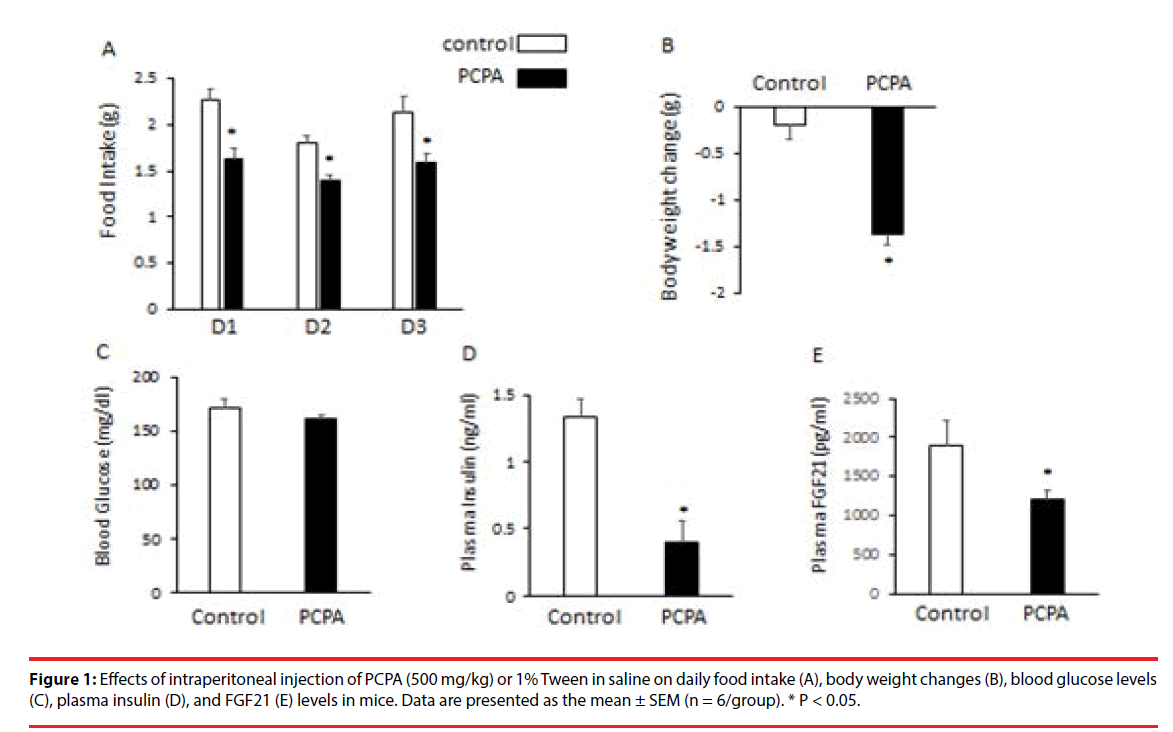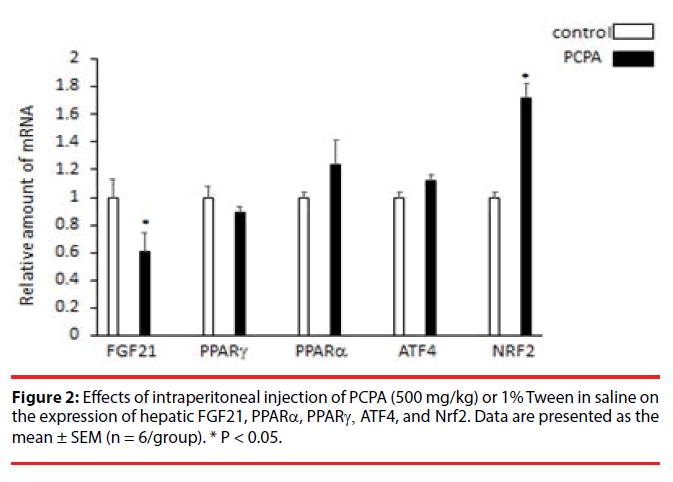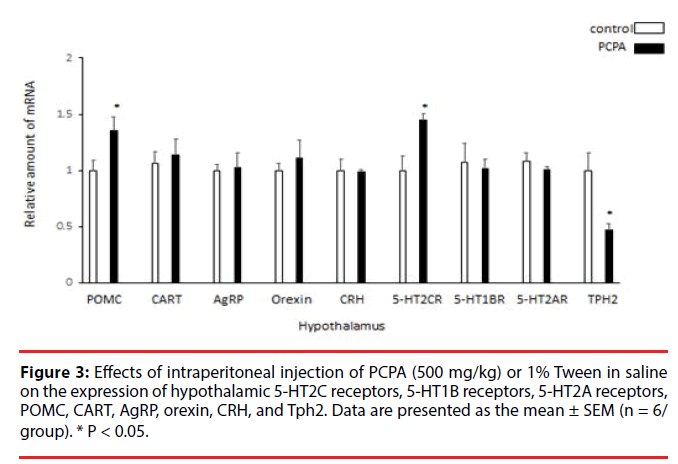Research Article - Neuropsychiatry (2018) Volume 8, Issue 1
A Tryptophan Hydroxylase Inhibitor Decreases Hepatic FGF21 Expression and Circulating FGF21 in Mice Fed A High-Fat Diet
- *Corresponding Author:
- Katsunori Nonogaki
Department of Diabetes Technology
Tohoku University Graduate School of Biomedical Engineering
6-6-11 Aramakiaza-Aoba, Aoba-ku, Sendai, Miyagi 980-8579, Japan
Tel: +81-22-795-3865
Fax: +81-22-795- 3865
Abstract
Abstract
Background: Fibroblast growth factor 21 (FGF21) is primarily secreted by the liver as an endocrine hormone, and circulating FGF21 levels are elevated in mice with diet-induced obesity and an insulin-resistant state. The aim of our study was to determine the role of serotonin (5-HT) in the regulation of hepatic FGF21 production and circulating FGF21 levels in relation to insulin resistance in mice fed a high-fat diet.
Methods and Results: Treatment with p-chlorophenylalanine (PCPA;500 mg/kg), a tryptophan hydroxylase inhibitor, for 3 days, which decreases brain-derived and peripheral serotonin (5-HT), significantly decreased food intake, body weight, and plasma insulin and FGF21 levels in mice fed a highfat diet for 9 weeks compared with controls, while having no statistically significant effect on blood glucose levels. PCPA treatment significantly decreased the expression of hepatic FGF21 and increased the expression of hepatic nuclear factor (erythroid-derived 2)-like2, while having no effects on the expression of hepatic peroxisome proliferator-activated receptor (PPAR)α, PPARγ, and transcriptional factor 4. Moreover, PCPA treatment significantly increased the expression of hypothalamic 5-HT2C receptors and pro-opiomelanocortin in mice fed a high-fat diet.
Keywords
Nrf2, Tph2, 5-HT2C receptor, POMC
Introduction
Serotonin (5-HT) has an important role in the regulation of energy homeostasis. Tryptophan hydroxylase (Tph) is the initial and rate-limiting enzyme in the synthesis of 5-HT. Tph has two isoforms: Tph1, which is primarily expressed in peripheral tissues, and Tph2, which is expressed in neural tissues, including the central nervous system [1]. Although Tph1-deficient mice fed a normal diet display normal food intake, body weight, and glucose tolerance, Tph1-deficient mice fed a high-fat diet are protected against obesity, insulin resistance, and non-alcoholic fatty liver [1]. On the other hand, Tph2- deficient mice fed a normal diet exhibit decreased food intake and increased energy expenditure, leading to decreases in body weight and fat pad weight [2,3]. Systemic administration of p-chlorophenylalanine (PCPA), a Tph inhibitor, remarkably decreases brain and serum 5-HT levels in mice [4-6] and prevents obesity and impaired glucose tolerance in mice fed a high-fat diet [7].
Fibroblast growth factor 21 (FGF21) is an atypical member of the FGF family that functions as an endocrine hormone to regulate glucose and lipid metabolism [8]. Although FGF21 is expressed in multiple organs, including the adipose tissue, thymus, skeletal muscle, and pancreas, it is primarily secreted by the liver as an endocrine hormone [9,10]. Circulating FGF21 is liverderived and is elevated in mice fed a high-fat diet [10]. Peroxisome proliferator-activated receptor (PPAR) α, PPARγ, transcriptional factor 4 (ATF4), and nuclear factor (erythroid-derived 2)-like 2 (Nrf2) are transcriptional factors of FGF21 in the liver [11-15]. The role of 5-HT in the regulation of hepatic FGF21 production and circulating FGF21 in relation to insulin resistance in mice fed a high-fat diet, however, remains unclear.
To determine the role of 5-HT in the regulation of hepatic FGF21 production and circulating FGF21 levels in relation to insulin resistance induced by a high-fat diet, we examined the effects of PCPA on food intake, body weight, blood glucose, plasma FGF21 and insulin levels, expression of hepatic FGF21 and the transcriptional factors of FGF21, and expression of hypothalamic 5-HT receptors and neuropeptides involved in the regulation of appetite in mice fed a high-fat diet. We hypothesized that 5-HT might contribute to increases in hepatic FGF21 expression and circulating FGF21 levels in mice fed a high-fat diet.
Methods
▪ General procedures
Five-week-old male C57BL6J mice were purchased from Japan CLEA. The mice were individually housed in cages with free access to water and chow pellets in a light- and temperature-controlled environment (12 h on/12 h off, lights on at 08:00; 20-22°C). Sixweek- old male C57BL6J mice were provided a high-fat diet (High Fat Diet 32, Japan CLEA) for 9 weeks. Then, the mice were intraperitoneally injected with saline or PCPA (500 mg/kg) once daily for 3 days. Daily food intake and body weight changes were determined. At the fourth day, the animals were decapitated and blood was obtained for the measurement of blood glucose, plasma FGF21 and insulin levels. The liver and hypothalamus were excluded for determining mRNA levels.
The experiment was performed between 9:00- 12:00. PCPA was purchased from Sigma Chemical Co., Japan. The PCPA was suspended in 0.2 ml 1% Tween saline. The dose of PCPA (500 mg/kg) was selected based on evidences that treatment with PCPA for 3 days remarkably decreased brain 5-HT and serum 5-HT levels in mice [5,6].
Whole blood was mixed with EDTA-2Na (2 mg/ml) and aprotinin (500 kIU/ml) to determine the plasma levels of FGF21. Plasma levels of FGF21 and insulin were measured by an enzyme-linked immunosorbent assay (rat/ mouse FGF21 ELISA kits; R&D System, Tokyo, Japan, mouse Insulin ELISA KIT(TMB) (AKRIN-011T, Shibayagi,Gunma, Japan) as described previously [16,17]. Blood glucose levels were measured using glucose strips (blood glucose monitoring system; Accu-Check, Roche Diagnostics, Tokyo, Japan). The animal studies were conducted in accordance with the institutional guidelines for animal experiments at the Tohoku University Graduate School of Medicine.
▪ Real-time quantitative reverse transcription–polymerase chain reaction (RT-PCR
Total RNA was isolated from mouse liver using the RNeasy Midi kit (Qiagen, Hilden, Germany) according to the manufacturer’s instructions. cDNA synthesis was performed using a Super Script III First-Strand Synthesis System for RTPCR Kit (Invitrogen, Rockville, MD) with 1 μg total RNA. cDNA synthesized from total RNA was evaluated in a real-time PCR quantitative system (LightCycler Nano Instrument Roche Diagnostics, Mannheim, Germany). The primers were used as follows: mouse FGF21, sense, 5’-CACCGCAGTCCAGAAAGTC -3’, and antisense, 5’-ATCAAAGTGAGGCGATCCA-3’; mouse PPARα, sense, 5’-CGGGTAACCTCGAAGTCTGA-3’, and antisense, 5’-CTAACCTTGGGCCACACCT-3’ ; mouse PPARγ, sense, ’-CTGCTCAAGTATGGTGTCCATGAG-3’, a n t i s e n s e , 5’-GAGGAACTCCCTGGTCATGAATC-3’; mouse Nrf2, sense, 5’-CAAGACTTGGGCCACTTAAAAGAC-3’, and antisense, 5’-AGTAAGGCTTTCCATCCTCATCAC-3’; mouse ATF4, sense, 5’-AGACACCGGCAAGGAGGATG-3’, and antisense, 5’-CGAAACAGAGCATCGAAGTCAAC-3’; mouse Tph2, sense, 5’-CGTGTGTGAAATCCTTTGAC-3’, and antisense, 5’-GGGGTTGAAGTATACCGAGA-3’; mouse β-actin, sense, 5’-TTG TAA CCA ACT GGG ACG ATA TGG-3’, and antisense, 5’- GAT CTT GAT CTT CAT GGT GCT AGG- 3’. The other primers were used as described previously [18-20].
The relative amount of mRNA was calculated using-actin mRNA as the invariant control. Data are shown as fold-change of the mean value of the control group, which received saline as described previously [16-20].
Statistical methods
Data are presented as mean ± SEM (n= 6). Comparisons between two groups were performed using Student’s t-test. A P value of less than 0.05 was considered statistically significant. Comparisons between more than two groups were performed using analysis of variance with Bonferroni’s correction for multiple comparisons.
Results
▪ Effects of treatment with PCPA on food intake, body weight, hyperglycemia and plasma insulin and FGF21 levels in mice fed a high-fat diet
Intraperitoneal injection of PCPA (500 mg/ kg) for 3 days significantly decreased daily food intake (Figure 1A), body weight (Figure 1B), plasma insulin (Figure 1D) and FGF21 levels (Figure 1E) compared with saline controls in C57BL6 mice fed a high-fat diet while having no significant effect on blood glucose levels (Figure 1C). These findings demonstrated that a tryptophan hydroxylase inhibitor suppresses daily food intake, body weight, plasma insulin and FGF21 levels in mice fed a high-fat diet.
▪ Effects of treatment with PCPA on expression of hepatic FGF21 and the transcriptional factors in mice fed a highfat diet
The treatment with PCPA for 3 days significantly decreased expression of hepatic FGF21 (40% decrease) and increased expression of hepatic Nrf2 (1.7-fold) while having no significant effects on expression of hepatic PPARα, PPARγ, and ATF4 (Figure 2). These findings demonstrate that a tryptophan hydroxylase inhibitor decreases expression of hepatic FGF21 and increases expression of hepatic Nrf2 in mice fed a high-fat diet.
▪ Effects of treatment with PCPA on expression of hypothalamic 5-HT receptors and neuropeptides involved in regulation of appetite in mice fed a highfat diet
The treatment with PCPA for 3 days significantly increased expression of hypothalamic 5-HT2C receptors (1.5-fold) and pro-opiomelanocortin (POMC) (1.4-fold) associated with decreased expression of hypothalamic Tph2 (50 %) in mice fed a high-fat diet while having no significant effect on expression of hypothalamic cocaine and amphetamine-regulated transcript (CART), agouti-related peptide (AgRP), orexin, corticotropin-releasing hormone (CRH), 5-HT1B receptors, and 5-HT2A receptors (Figure 3). These findings suggest that a tryptophan hydroxylase inhibitor increases hypothalamic 5-HT2C receptor and POMC expression in mice fed a high-fat diet.
Discussion
The results of the present study demonstrated that PCPA treatment decreased food intake, body weight gain, and insulin resistance associated with decreases in hepatic FGF21 production and circulating FGF21 levels in mice fed a high-fat diet. Our results support a previous report that treatment with PCPA prevents obesity in mice fed a high fat diet [7]. Treatment with PCPA inhibits lipogenesis in epididymal white adipose tissue and promotes thermogenesis via uncoupling prietin-1 (UCP1) in brown adipose tissue, leading to weight loss in mice fed a high- fat diet [7]. Although treatment with PCPA (300 mg/kg) for 12 weeks did not suppress daily food intake in the previous report [7], our results demonstrated that treatment with the PCPA (500 mg/kg) for 3 days significantly suppressed daily food intake in mice fed a highfat diet. The differences in the effect of PCPA on food intake might be due to the differences in the doses of PCPA. Tph1-deficient mice fed a high-fat diet are protected against obesity and insulin resistance via promoting thermogenesis via UCP-1 in brown adipose tissue without affecting food intake [1,2]. On the other hand, Tph2-deficient mice fed a normal diet exhibit decreased food intake and increased energy expenditure, leading to decreases in body weight and fat pad weight [1,3]. Although treatment with PCPA (500 mg/kg), an inhibitor of both Tph1 and Tph2, remarkably decreases brain 5-HT synthesis and serum 5-HT levels [5,6], the lower dose (300 mg/kg) might be less effective on the inhibition of Tph2 in mice fed a high-fat diet. We also cannot rule out the differences in the acute and chronic effects of PCPA.
FGF21 is induced by PPARα in the liver in response to fasting, PPARα agonists, and a highfat and low-carbohydrate ketogenic diet [8-12]. In addition, FGF21 is a downstream target of PPARγ and is required for the anti-diabetic effects of PPARγ agonists [13]. Moreover, hepatic FGF21 is induced by ATF4, which is activated by metformin [14]. On the other hand, Nrf2 downregulates hepatic FGF21 production [14]. Nrf2-deficient mice have higher plasma FGF21 levels and higher FGF21 mRNA levels in the liver than wild-type mice [15]. Our results demonstrated that treatment with PCPA decreased hepatic FGF21 expression independently of PPARα, PPARγ, and ATF4, but possibly due to increased expression of Nrf2 in mice fed a high-fat diet. Thus, a tryptophan hydroxylase inhibitor might contribute to the expression of hepatic Nrf2 and FGF21 in mice fed a high-fat diet.
In addition, our results demonstrated that decreases in hepatic FGF21 production and circulating FGF21 induced by PCPA treatment were associated with decreased insulin resistance in mice fed a high-fat diet. On the other hand, circulating FGF21 is based on liver-derived FGF21 and FGF21-liver specific knockout mice fed a high-fat diet display increased insulin resistance [15]. The differences might be due to the differences in plasma FGF21 levels between mice treated with PCPA and mice with liverspecific FGF21 knockout. Plasma FGF21 levels are completely abolished in liver-specific FGF21 knockout mice fed a high fat diet, whereas the mean FGF21 levels in plasma were decreased (64%) in the PCPA-treated mice fed a highfat diet. We previously reported that increases in physiologic circulating FGF21 levels are related to impaired glucose tolerance in mice [19]. Moreover, in humans, plasma FGF21 levels are reportedly increased in subjects with prediabetes and type 2 diabetes [21], and predict the insulin resistant state and development of type 2 diabetes [21,22]. From these findings, we raise the hypothesis that the increases in physiologic circulating FGF21 levels in mice fed a high-fat diet are related to insulin resistance, and that decreasing the abnormally increased FGF21 levels to a physiologic range might lead to improved insulin resistance.
Moreover, our results demonstrated that the decreased hepatic FGF21 production and insulin resistance induced by PCPA treatment were associated with increased expression of hypothalamic 5-HT2C receptors and POMC in mice fed a high-fat diet. 5-HT2C receptordeficient mice fed a high-fat diet rapidly develop obesity, insulin resistance, and type 2 diabetes [23]. 5-HT2C receptors expressed by POMC neurons are physiologically relevant regulators of insulin sensitivity and glucose homeostasis in the liver [24]. The increased hypothalamic 5-HT2C receptor and POMC expression might therefore contribute to decrease food intake, body weight and insulin resistance induced by PCPA in mice fed a high-fat diet. Further studies will be needed to determine mechanisms by which the pharmacologic inhibitor of 5-HT synthesis decreases hepatic FGF21 expression and circulating FGF21 levels, and increases hypothalamic 5-HT2C receptor and POMC expression in mice fed a high-fat diet in future.
In summary, these findings suggest that a Tph inhibitordecreases hepatic FGF21 production and circulating FGF21 levels in relation to improved insulin resistance, and increases the expression of hypothalamic 5-HT2C receptors and POMC in mice fed a high-fat diet.
Conflict of Interest
The authors declare that they have no conflicts of interest.
Acknowledgment
This work was supported by a Grant in-Aid for Scientific Research.
References
- Savelieva KV, Zhao S, Pogorelov VM, et al. Genetic disruption of both tryptophan hydroxylase genes dramatically reduces serotonin and affects behavior in models sensitive to antidepressants.PLoS. One 3(10), e3301 (2008).
- Crane JD, Palanivel R, Mottillo EP, et al. Inhibiting peripheral serotonin synthesis reduces obesity and metabolic dysfunction by promoting brown adipose tissue thermogenesis. Nat. Med 21(2), 166-172 (2015).
- Yadav VK, Oury F, Suda N et al. Leptin regulation of bone mass, appetite and energy expenditure relies on its ability to inhibit serotonin synthesis in the brainstem. Cell 138(5), 976-989 (2009).
- Lam DD, Leinninger GM, Louis GW, et al. Leptin does not directly affect CNS serotonin neurons to influence appetite. Cell. Metab 13(5), 584-591 (2011).
- Liu Y, Jiang Y, Si Y, et al. Molecular regulation of sexual preference revealed by genetic studies of 5-HT in the brains of male mice. Nature 472 (7341), 95–99 (2011).
- Weng R, Shen S, Tian Y, et al. Metabolomics approach reveals integrated metabolic network associated with serotonin deficiency. Sci. Rep 5, 11864 (2015).
- Oh C-M, Namkung J, Go Y, et al. Regulation of systemic energy homeostasis by serotonin in adipose tissues. Nat. Commun 6(1), 6794 (2015).
- Kharitonenkov A, DiMarchi R. FGF21 revolutions: recent advances illuminating FGF21 biology and medicinal properties. Trends. Endocrinol. Metab 26(11), 608-617 (2015).
- Woo YC, Xu A, Wang Y, et al. Fibroblast growth factor 21 as an emerging metabolic regulator: clinical perspectives. Clin. Endocrinol (Oxf) 78(4), 489-496 (2013).
- Markan KR, Naber MC, Ameka MK, et al. Circulating FGF21 is liver derived and enhances glucose uptake during refeeding and overfeeding. Diabetes 63(12), 4057-4063 (2014).
- Inagaki T, Dutchak P, G. Zhao G et al. Endocrine regulation of the fasting response by PPARalpha-mediated induction of fibroblast growth factor 21. Cell. Metab 5(6), 415-425 (2007).
- Badman MK, Pissios P, Kennedy AR, et al. Hepatic fibroblast growth factor 21 is regulated by PPARa and is a key mediator of hepatic lipid metabolism in ketotic states. Cell. Metab 5(6), 426-437 (2007).
- Dutchak PA, Katafuchi T, Bookout AL, et al. Fibroblast growth factor-21 regulates PPARγ activity and the antidiabetic actions of thiazolidinediones. Cell 148(3), 556-567 (2012).
- Kim KH, Jeong YT, Kim SH, et al. Metformin-induced inhibition of the mitochondrial respiratory chain increases FGF21 expression via ATF4 activation. Biochem. Biophys. Res. Commun 440(1), 76-81 (2013).
- Chartoumpekis DV, Ziros PG, Psyrogiannis AI, et al. Nrf2 represses FGF21 during long-term high fat diet-induced obesity in mice. Diabetes 60(10), 2466-2473 (2011).
- Nonogaki K, Hazama M, Satoh N. Liraglutide suppresses obesity and hyperglycemia
- associated with increases in hepatic fibroblast growth factor 21 production in KKAy mice, Biomed. Res. Int 751930 (2014).
- Nonogaki K, Kaji T. α1-Adrenergic receptor downregulates hepatic FGF21 production and circulating FGF21 levels in mice. Neurosci. Lett 638(1), 35-38 (2017).
- Nonogaki K, Kaji T. Hypothalamic orexin and pro-opiomelanocortin activities are essential for the anorexic effects of m-chlorophenylpiperazine in mice. Int. J. Neuropsychopharmacol 13(9), 1261-1267 (2010).
- Nonogaki K, Nozue K, Oka Y. Increased hypothalamic 5-HT2A receptor gene expression and effects of pharmacologic 5-HT2A receptor inactivation in obese Ay mice. Biochem Biophys Res Commun 351(4), 1078-1082 (2006).
- Nonogaki K, Kaji T. The acute anorexic effect of liraglutide, a GLP-1 receptor agonist, does not require functional leptin receptor, serotonin, and hypothalamic POMC and CART activities in mice. Diabetes. Res. Clin. Pract 120(1), 186-189 (2016).
- Chavez AO, Molina-Carrion M, Abdul-Ghani MA, et al. Circulating fibroblast growth factor-21 is elevated in impaired glucose tolerance and type 2 diabetes and correlates with muscle and hepatic insulin resistance. Diabetes. Care 32(8), 1542-1546 (2009).
- Chen C, Cheung BM, Tso AW, et al. High plasma level of fibroblast growth factor 21 is an independent predictor of type 2 diabetes: a 5.4 year population-based prospective study in Chinese subjects. Diabetes. Care 34(9), 2113-2115 (2011).
- Nonogaki K, Strack AM, Dallman MF, et al. Leptin-independent hyperphagia and type 2 diabetes in mice with a mutated serotonin 5-HT2C receptor gene. Nat. Med 4(10), 1152-1156 (1998).
- Xu Y, Berglund ED, Sohn JW, et al. 5-HT2CRs expressed by pro-opiomelanocortin neurons regulate insulin sensitivity in liver. Nat. Neurosci 13(12), 1457-1459 (2010).


